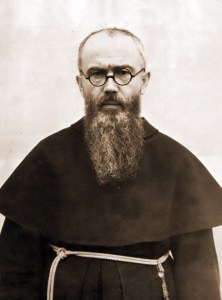We support our Publishers and Content Creators. You can view this story on their website by CLICKING HERE.
As the man pleaded his case, Father Maximilian Kolbe came forward and offered his life for the one pleading. The German commandant of Auschwitz—probably rather shocked—agreed, and Kolbe, with nine others, stripped naked and entered the 3-foot-high concrete bunker.
 As Hillsdale students approach my desk on the fourth floor of Delp Hall, several things stand or sit between me and them. There’s the huge desk, of course. But, on the desk sits a lamp, some books, a MacBook, and a small figurine of a monk, one of his hands broken off. Some of my own knowledge of the figurine itself is foggy, as I no longer remember why his hand is missing. I do know that I purchased the figurine at a nunnery in Ohio many years ago.
As Hillsdale students approach my desk on the fourth floor of Delp Hall, several things stand or sit between me and them. There’s the huge desk, of course. But, on the desk sits a lamp, some books, a MacBook, and a small figurine of a monk, one of his hands broken off. Some of my own knowledge of the figurine itself is foggy, as I no longer remember why his hand is missing. I do know that I purchased the figurine at a nunnery in Ohio many years ago.
The figurine is of one of my great heroes, a Catholic saint and priest. I almost always get the same reaction from my students. Typically, they pick him up and say something like “Oh, I like your monk action figure, Dr. Birzer.” Usually, a slight but sympathetic laugh or giggle accompanies the question as they continue to examine the figure.
“Oh, do you know who that is?” I ask. The usual guess is: “St. Benedict”? A legitimate guess, especially given that we teach the rule of St. Benedict to all of our freshmen and that I have such a fondness for Miller’s Canticle for Leibowitz.
No, I explain, this man died on August 14, 1941, in cell block 13, the worst of all punishments handed out by the National Socialists in Auschwitz prior to the employment of the ovens and gas chambers.
St. Maximilian Kolbe, a Roman Catholic priest, had been taken prisoner by the Nazis, as had been vast number of his fellow men, Poles, Jews, Catholics, and Lutherans. The Nazis seemed to avoid discrimination when it came to state sanctioned murder.
On the last day of July, 1941, a prisoner had attempted to escape the terror camp. As punishment, the commandant called out 10 random names—the names of those to be executed in retribution for the one man trying to escape. One of the names called had belonged (or, rather, had been forced upon) a husband and father. As the man pleaded his case, Father Kolbe came forward and offered his life for the one pleading. The commandant, probably rather shocked, agreed, and Kolbe, with nine others, stripped naked and entered the concrete bunker. Deprived of food, water, light, and toilets, the men survived—unbelievably—for two weeks. Madness and cannibalism had never overcame them, as the Nazis had hoped. Instead, through Kolbe’s witness as priest and preacher and as an incarnate soul made in the Image of Christ, grace pervaded the room. When the commandant had the room searched two weeks later, only to find the men and Father Kolbe alive, he furiously ordered them all to be injected with carbolic acid.
The man who removed Kolbe’s body offered a wondrous testimony under oath. Kolbe, he said, had been in a state of definite ecstasy, his eyes focused on something far beyond the bunker, his arm outstretched, ready to accept the death of the chemicals to be injected in him.
At this point in the story, the student almost always puts down the figure of St. Maximilian Kolbe, a little surprised, a little overwhelmed, a little impressed, and with a bit of reverence.
No mere action figure sits on my desk.
There sits a representation of the saint of the twentieth century, patron of the 205 million men, women, and children murdered by their governments because they were each and every one of them an unrepeatable center for dignity and freedom, made for beauty and eternity, not for the whim of governor, bureaucrat, commandant, or ideologue.
This essay was first published here in August 2010.
The Imaginative Conservative applies the principle of appreciation to the discussion of culture and politics—we approach dialogue with magnanimity rather than with mere civility. Will you help us remain a refreshing oasis in the increasingly contentious arena of modern discourse? Please consider donating now.
The featured image is a photograph of Maximilian Kolbe in 1936, and is in the public domain, courtesy of Wikimedia Commons.
Share This Story, Choose Your Platform!
Go to Top

 Conservative
Conservative  Search
Search Trending
Trending Current News
Current News 






